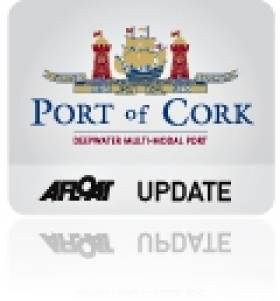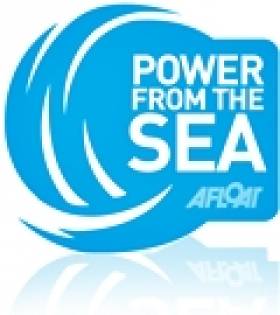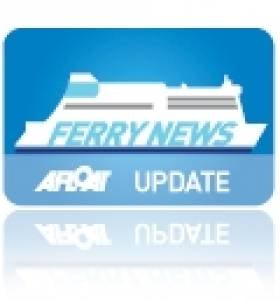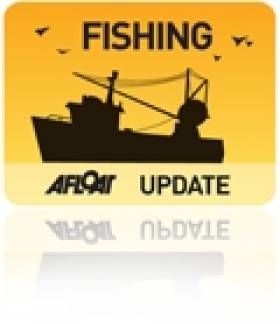Displaying items by tag: Ports and Shipping
€500k Sought to Restart Cork-Swansea Ferry Link
#FERRY NEWS - Approximately €500,000 is to be sought from three local authorities in the south-west region so to help restart the Cork-Swansea route which was served by the M.V. Julia (1982/22,161grt) until sailings ceased in November last year.
Representatives from Fastnet Line Ship Holdings Ltd are expected to attend a special meeting of Cork County Council next Monday at which they will outline a business plan for the company, which is in examinership.
They will also address a scheduled meeting of Cork City Council later the same day and are expected to communicate their request to Kerry County Council shortly.
For more about this story in today's Examiner click HERE
‘Resilient’ Performance by Port of Cork in 2011
#PORT OF CORK - Port of Cork Company chairman, Mr Dermot O'Mahoney, yesterday announced end of year trade traffic results for the Port of Cork in 2011. He said: "Trade traffic has shown remarkable resilience recording 8.8 million tonnes despite experiencing challenging periods during 2011." These figures are on a par with 2010 figures at the Port of Cork.
A remarkable feature of the figures is the very positive effect on the local economy by the increase in exports from the Port. Total exports at the Port of Cork have remained strong increasing by 9% in comparison to 2010 and by 19% since 2009. Exports are a key driver in the successful recovery of the Irish Economy and the Port of Cork is committed to continuous support in the growth of international trade for both current and future economic prospects.
Although the growth in export volumes to pre –recession levels reflects the rapid "V" shaped bounce back by the export sector which was achieved despite the depressed international economic environment, import volumes are still 12.9% below 2007 levels. The continued low volume of imports is inevitably putting huge strain on the ports, shipping lines and transport sector servicing the country.
The container business at the Port of Cork has shown an increase of 5% with over 150,000 TEU handled in 2011. Animal feed stuffs, fertiliser and other trades have shown a marginal decrease in 2011. Oil traffic has remained steady despite the lower levels of domestic economic activity; however exports of refined product from Conoco Phillips Whitegate Oil Refinery has remained strong and continues to be a significant part of the Port of Cork business.
Remarking on the end of year trade traffic results, Mr Dermot O'Mahoney Chairman of the Port of Cork said: "The Port of Cork is pleased to announce that total trade traffic in 2011 has remained strong with exports increasing by 9% over 2010 volumes. With 98% of all goods imported or exported from Ireland moved by ship, the importance of ports to our economy is of vital strategic importance. The Port of Cork is a key link to the continued economic success of Ireland and in particular the entire Munster region. The challenge now facing the Port of Cork is to continue to develop to meet the needs of the Country as it emerges from this current recession. This requires that we be visionary and seize opportunities presented by emerging trends and logistic supply changes."
He continued: "While the next four to five years will be challenging for us all, we need to continue to promote the fact that Ireland is an excellent investment location and is well placed to capitalise on growing global markets as is evident by our export sector."
53 cruise vessels visited the Port of Cork during 2011 bringing over 100,000 passengers and crew to the region and the Port is scheduled to accommodate 60 vessels in 2012. According to research carried out by UK Consultants GP Wild, the average in-transit spend per passenger, while visiting an Irish port is between €73- €100 which provides a significant contribution towards the local tourism economy. In 2011 the Port of Cork won 1st place for 'Best Destination Experience (Organised)' in the world and 2nd place for 'Best Port Welcome' in the Dream World Cruise Destinations Awards. This achievement highlighted the outstanding team effort and commitment by the Port of Cork to deliver an excellent service to the visiting cruise lines and their passengers when in Cork. Ireland Inc. also received a Commendation as a "Destination where the Quality and Professionalism of Tour Guides is considered outstanding".
Port officials are pro-actively engaged with tourism interests, County and City Councils and destination attractions to enhance the product on offer to the visiting cruise lines with a view to growing the business further through its dedicated cruise terminal.
Ferry passenger numbers with Brittany Ferries remained steady on its weekly ferry service from Cork to Roscoff and the Port awaits the outcome of the Examinership of Fastnet Lines and the re-commencement of the ferry service linking Cork with Swansea.
The Port of Cork's recreational strategy continues to expand with the aim of improving the marine leisure facilities around Cork Harbour.
Mr O' Mahoney concluded by saying that "the Port of Cork must continue to reinforce its existing strength as the primary deep-water port in the south of Ireland and build on our progress so far by effectively resolving our challenges in an imaginative way and with a strong sense of urgency and determination."
#POWER FROM THE SEA - This morning the wind farm turbine installation vessel Sea Energy, departed Wicklow Bay having spent over a fortnight based in Wicklow Port, where her Danish crew celebrated Christmas Day, writes Jehan Ashmore.
The Esbjerg registered vessel operated by A2 Sea, arrived in the week before Christmas to work at Airtricity's Arklow Bank Wind Farm, but the nature of the work was based on internal operations only at the seven turbine facility, which each structure scaling to a height of over 70 metres / 240 feet.
Upon completion of her work, she returned to Wicklow where her crew spent the festive season in port with a Christmas tree complete with lights! at the bow.
She remained in the harbour into the New Year and during the recent spate of heavy weather until finally departing yesterday on Little Christmas, where she overnighted in the bay.
With four towering supporting jack-up legs each 32 metres high, this enables her to carry out offshore crane operations with greater control. In addition the vessel is raised completely above the water to gain elevation to assist mounting the pre-assembled wind-turbine components from her deck cargo.
She can work in waters of up to 24 metres and as she rests on the sea-bed this provides a more stable working platform.
Sea Energy presented a distinctive profile while in port as she 'sat' close to the Packet Quay, as her jack-up legs make mooring ropes redundant.
The quay is the main commercial quay and during this week she vacated the berth to allow regular caller Scot Isles (2001/2,595grt) which arrived with a cargo of sawn packaged timber products from Scandinavia. Owned by Scot Line, the vessel remained in the port for two days and then departed for Warrenpoint.
The Wicklow Port Company also specialise in dry-cargoes, lead, and scrap-metal as previously reported, to read more click HERE.
It is somewhat unusual for vessel movements in Wicklow to berth outside the harbour piers, as in the case with Sea Energy.
She shifted berths to the seaward side of the West Pier and again she sat with jack-legs lowered in water depths of six metres, leaving a clearance of around two metres below the keel.
Although Arklow is closer to the wind-farm than Wicklow, Sea Energy's 3,332 gross tonnes is too large to be accommodated as the port on the River Avoca has a has lower water depth.
High Court Extends Protection for Cork-Swansea Ferry Operators
#FERRY NEWS-A High Court judge has agreed to continue court protection for the companies operating the Cork-Swansea ferry service to allow for finalisation of a survival scheme, reports The Irish Times.
Mr Justice Peter Kelly said yesterday he was satisfied to extend the protection period for the companies to January 24th next.
The extension of time was sought by Declan Murphy, for the companies' examiner Michael McAteer, to allow time for an investment agreement to be signed and a survival scheme put before meetings of creditors.
Fastnet Line Ship Holdings Ltd (100 per cent owned by the West Cork Tourism Co-operative Society Ltd) and related companies operating the ferry service using the M.V. Julia (1981/22,161grt) from the ferry terminal at Ringaskiddy, Co Cork, secured court protection last month.
Later Noel Murphy, chairman of the West Cork Tourism Co-Operative Society, said they had outlined the urgent funding required to secure the future of the service, which will allow them to present a financial proposal to the examiner in early January.
To date €673,000 has been raised by individual donors, customers, shareholders and local businesses, leaving just under €1 million to be raised.
New Telecoms Cable to Link-Up with London and Europe
# PORTS & SHIPPING -A specialist cable-laying vessel, Cable Innovator (1995/14,277 tonnes) arrived into Dublin Port yesterday. She is due start work next week on a €12.5m telecoms cable for CeltixConnect between Dublin and Holyhead.
According to a report in The Irish Times (click HERE) CeltixConnect's chief executive Diane Hodnett expected customers to start transmitting traffic on the cable at the end of January.
The cable will pass through the East Point Business Park in Dublin and on to the city's IFSC. On the Welsh side, the 131km cable will connect to the Welsh Assembly-funded Parc Cybi business park in Holyhead. From there it will connect to networks linking Manchester, London and the rest of Europe.
Capacity on the cable will be sold primarily to telecoms firms and ISPs, mobile phone operators and a small number of multinationals in the technology space which have massive bandwidth requirements.
For more information about the UK-flagged vessel which berthed in the port's Alexandra Basin, click this LINK.
New Irish Sea Telecoms Cable to Link-Up London and Europe
# PORTS & SHIPPING -A specialist cable-laying vessel, Cable Innovator (1995/14,277 tonnes) arrived into Dublin Port yesterday. She is due start work next week on a €12.5m telecoms cable for CeltixConnect between Dublin and Holyhead.
According to a report in The Irish Times (click HERE) CeltixConnect's chief executive Diane Hodnett expected customers to start transmitting traffic on the cable at the end of January.
The cable will pass through the East Point Business Park in Dublin and on to the city's IFSC. On the Welsh side, the 131km cable will connect to the Welsh Assembly-funded Parc Cybi business park in Holyhead. From there it will connect to networks linking Manchester, London and the rest of Europe.
Capacity on the cable will be sold primarily to telecoms firms and ISPs, mobile phone operators and a small number of multinationals in the technology space which have massive bandwidth requirements.
For more information about the UK-flagged vessel which berthed in the port's Alexandra Basin, click this LINK.
Seatruck's New Freight-Ferry on Delivery Voyage
#FERRY NEWS-Seatruck Progress (photo), the first of two 18,900 gross tonnes ro-ro newbuilds due to enter on Seatruck Ferries Dublin-Liverpool route, is en -route in the English Channel today from German builders, FGS Flensburg, writes Jehan Ashmore.
Her sister Seatruck Power is due to join her fleetmate on the central corridor service by mid-February. In addition Seatruck have on order another pair of the same class from FGS which are to be completed in 2012 and are likely to be deployed on the company's other Irish Sea routes.
The new quartet each measure 142m and will offer 2,166 lane freight-metres spread over four decks. They will each have a capacity of 150 units, 35 more than Seatruck's current P Series vessels in which Clipper Point and Clipper Pennant are currently employed on the route.
The company operate 80 sailings per week on four routes: Dublin-Liverpool,Dublin- Heysham, Warrenpoint-Heysham and Larne-Heysham. The newbuilds will also be the largest vessels ever to operate out of Heysham.
In the last two years freight volumes doubled and Seatruck has 20% of the Irish Sea market as against 3.7% in 2004. This year Seatruck will ship 300,000 units on the Irish Sea and with the fleet expansion this total will grow substantially in 2012.
Cruiseships Great and Small Lineup for Dublin 2012
#CRUISE LINERS- Around 85 cruiseships are scheduled to call to Dublin Port in 2012, which compares closely to the same number of calls for this year's season, writes Jehan Ashmore.
First to start the season will be Grand Princess, which has the accolade of being the inaugural cruiseship to enter the port with a tonnage surpassing the 100,000 gross tonnes. The milestone was marked by the Princess Cruises call in 2004.
As usual with that number of cruise-callers, the variety of vessels will range from the small to the very large. A prime example is the diminutive expedition cruiseship Quest (1,180 tonnes) and at just under 50-metres long has just over the same number in passenger capacity.
In complete contrast to the ice-strenghtened Quest is the giant Caribbean Princess, a larger sister of Grand Princess, can accommodate over 3,000 passengers and she is make several calls.
Noble Caledonia which has been operating Quest (PHOTO) on successful seasons in Scotland, is to embark on itineraries next season to Ireland, England and Wales for the first time. Her half-sister Ocean Nova has called to Dublin on previous occasions.
For only the second time, Queen Elizabeth is due return to the capital (for report click HERE) in late Summer and in the same week, Hebridean Princess is also scheduled to call. The later vessel in recent years was chartered to Queen Elizabeth II, for a cruise off the Scottish Isles. To read more on the small ship's visit to the port earlier this year click HERE.
Fish Processing Trawler Calls to Dublin Port
#FISH PROCESSING- An unusual type of vessel to visit Dublin Port was the Faeroe Islands-flagged fish processing vessel Naeraberg (KG-14) which made a brief call this week, writes Jehan Ashmore.
The 3,181grt vessel built in 1983 at Harlingen Scheepswer in The Netherlands, berthed at the Coal Quay on the south docks. This berth is normally used for cargo such as molasses and loading scrap metals and where vessels occasionally call to collect supplies and parts.
Large fishing vessels visit the port though primarily for dry-docking purposes, notably in the case of the Killybegs based Antarctic (D97). The vessel is one of several operated by Arctic Fish Sales, a fresh fish trading company in operation over the last two decades.
She called to the port during late Summer, to the single-graving dock facility at Dublin Graving Docks. The facility can be divided into two separate chambers so to accommodate ships simultaneously.
Former Dundalk Dredger Sold in Dublin Port
#DUBLIN PORT-The former Dundalk Port Company grab-hopper dredger Hebble Sand (1963/757grt), which has been laid-up in Dublin since last Summer, was sold to new owners a month ago, writes Jehan Ashmore.
She remains berthed at the Bulk Jetty, Alexandra Basin, where she arrived from the Co. Louth port on 14 July, two days after the assets, liabilities and operations of Dundalk Port Company were transferred to Dublin Port Company by an order of statutory instrument. Against this background, Dublin Port Company decided to divest in the business of dredging resulting in placing the veteran vessel for sale.
During her career in Drogheda, she was the only dredger to be operated and owned by a port company apart from the suction-trailer dredger Lough Foyle (1979/868grt) operated by Londonderry Port & Harbour Commissioners.
Hebble Sand, registered in Dundalk has retained her original name since her launch from Richard (Shipbuilders) of Lowestoft for British Dredging. She has been kept in good condition considering a career nearing five decades. To read some of her last contracts undetaken outside her homeport, click HERE.
From a distance some people have mistaken Hebble Sand (PHOTO) to the last of the 'Guinness ships, as she bores a resemblance to the final custom-built stout tanker Miranda Guinness ( PHOTO), taken on her farewell sailing. The vessels shared a similar red funnel and black funnel, a roomy sized superstructure painted in cream above and a dark blue hull. To read more about the last of the brewery tanker-fleet click HERE.
































































